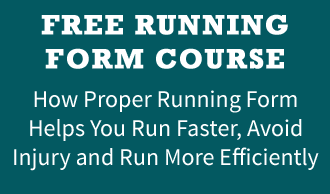Last week we looked at how hard anaerobic running (short races and speed workouts) can result in fatigue-related changes in running form. But the tired feeling you get after an interval workout or a 5k race isn’t the only kind of fatigue which can affect your running, nor is it the most common for typical runners.
The fatigue you might feel after an easy or moderate run is different than the “metabolic fatigue” that accompanies an interval workout. In the case of aerobic runs, you are mostly tired because your muscles and nervous system have been working for a long time.
To link this type of fatigue with the changes in running form that result from metabolic fatigue would be a mistake.
To see what changes, if any, occur from the fatigue you feel at the end of a longer run or an aerobic workout—a feeling we might term “exertional fatigue”—we need to look at a different set of scientific studies.
Exertional fatigue in action
Like measuring changes due to metabolic fatigue, studies on exertional fatigue-related form changes involve evaluating the running mechanics or efficiency of a group of runners before and after a workout which induces the desired type of fatigue. One such study was published in 2008 by John Sproule at the Chichester Institute of Higher Education in the UK.
In Sproule’s study, 15 young men studying physical education had their oxygen consumption measured before and after three trial runs, each separated by a week’s rest. The trials consisted of a 40-min run at 80% of VO2 max, a 60-min run at 70% of VO2 max, and a 60-min run at 80% of VO2 max. For reference, marathon pace is about 80-85% of VO2 max for serious marathoners.
Study results
Sproule’s results showed that the cost of running increases significantly after these long, continuous workouts.
- Oxygen consumption increased by about 5-10%, probably because of muscular fatigue, as suggested by Daijiro Abe and other researchers at the University of East Asia in Japan. They conducted a study which measured the electrical activity of the quad muscles throughout the duration of a 90-min run.
- As the runners became more fatigued from the continuous running, they had to rely more on concentric muscle action to propel themselves off the ground rather than eccentric muscle action to absorb impact shock and use it to rebound, which saves energy.
So, if the “prime mover” muscles of the body get progressively more fatigued during a long, tiring run, does this affect running mechanics? And moreover, does it affect the smaller muscles which control some of the finer aspects of form, like hip adduction and knee rotation?
Does exertional fatigue affect running mechanics on long, easy runs?
Tracey Dierks, Irene Davis, and Joseph Hamill published an article in 2010 which addressed these questions by having 20 runners perform a treadmill run at the pace of a typical training run. The treadmill was surrounded by gait analysis equipment, which allowed Dierks, Davis, and Hamill to track the motion of the lower body as the runners became fatigued.
Though the researchers noted small increases in pronation in the foot and internal rotation at the knee, overall stride patterns did not change very much.
However, a similar study conducted by the same research group demonstrated that runners with patellofemoral pain syndrome (also known as runner’s knee) as well as healthy runners both display reduced hip strength at the end of a treadmill run representative of a prolonged training run at an easy pace.
For the injured runners, this decrease in hip strength was strongly associated with abnormal hip mechanics—a phenomenon not observed before the run or in the healthy runners.
While it appears that exertional fatigue-related changes in running mechanics are small in healthy runners, there is a significant interaction between muscular fatigue at the end of a prolonged training run and abnormal mechanics in runners with a knee injury.
The fatigue-related changes to hip mechanics linked to injury by Dierks et al. are most likely to occur after long training runs and when you’re increasing your mileage—something which already leaves you more exposed to injury.
This is something that you should keep in mind if you’ve had an injury that’s been associated with muscular deficiencies, especially in the hips. This includes patellofemoral pain syndrome (runner’s knee), IT band syndrome, and medial tibial stress syndrome (shins splints).
The increased injury risk on long runs one of the main reasons the coaches here are RunnersConnect have long been a proponent of reducing long run volume during marathon training for beginner or injury-prone runners.
Though healthy runners don’t have to worry too much about changes in their running form during long aerobic runs, runners who are currently injured, do not have a solid base of mileage, or perhaps have had gait-related injuries in the past should be aware that the same poor running form that caused their injury could return or get worse as they get progressively more tired.
Recommendations
- Don’t overemphasize the long run, especially when training for the marathon. Not only do aerobic benefits flat line after 2 hours of running, but as this research shows, injury risk increases significantly. Instead of 20-22 milers, consider 16-18 milers with marathon specific work buttressed against a steady run the day before.
- Thing prehab rather than rehab. Work on strengthening known or potential weak areas in your running mechanics. For example, if you suffer from knee injuries, work on increasing your hip strength.
- Fix flaws in your running form that become exacerbated during long runs. Improving posture, learning to generate proper hip extension, and fixing overstriding can help prevent many potential injury issues.
RunnersConnect Bonus
Download your FREE Long Run and Aerobic Pacing Calculator now.
Need help converting your race times to your optimal easy and long run pace? Download our FREE calculator and we’ll do the math for you.






2 Responses
Think I’m guilty of the above concerning the long runs! I am a slow runner–actually more of a jog-walk person, as per Jeff Galloway! Plus I really want to learn the Chi technique, but have been totally struggling with it, as I feel I have never found the perfect running shoes…right now I’m in the Brooks Pure Flows, but still not totally satisfied…and then there’s “Barefoot Ken” who doesn’t believe in shoes. If running could always be done on the artificial turf of football field, I might be in business (I ran in socks but no shoes on the field, as well as in my house on carpet a couple times, and good running form felt so easy for a few minutes, then I put my Brooks back on and…poof!). Anyway, had “mastered” the half marathon in around 2:45…so trained for my first full marathon last spring with a goal of 5:45 (which I missed by about 40 minutes). My knees bothered me, so I walked a lot in the three 20-mile training “runs” that I did, and it still took me into the middle of the following week to recover. So I guess I overdid it on the 20 milers, and I already had the idea of doing just a few two to three hour long “runs” (run/walk), and MAYBE only ONE 20-miler…or splitting it into two 10 milers on one day (from previous articles and books I’ve read lately)…for my next marathon. However, I’m now struggling with the half marathon, so maybe I’m just not cut out for long distance runs. 🙁 Thoughts?
Sorry you’ve struggled, Shirley. Your story isn’t uncommon though.
First, there is no single best way to run. Despite claims made by marketed running styles like Chi, Pose and Evolution, differences in our biological make-up strongly suggests that what works for one runner will not necessarily work for everybody.The fact that elite, world class runners possess different running styles strengthens the argument against a one-style-fits-all approach. I would look towards a more holistic approach: https://runnersconnect.net/running-training-articles/heelstriking-running-cadence/
As for your long runs, given your times, paces and injury history, there is no need for 20-milers during the training phase. See here: https://runnersconnect.net/coach-corner/are-you-putting-too-much-emphasis-on-the-long-run-as-part-of-your-marathon-training/
Hope that info helps you plan your next marathon or HM better